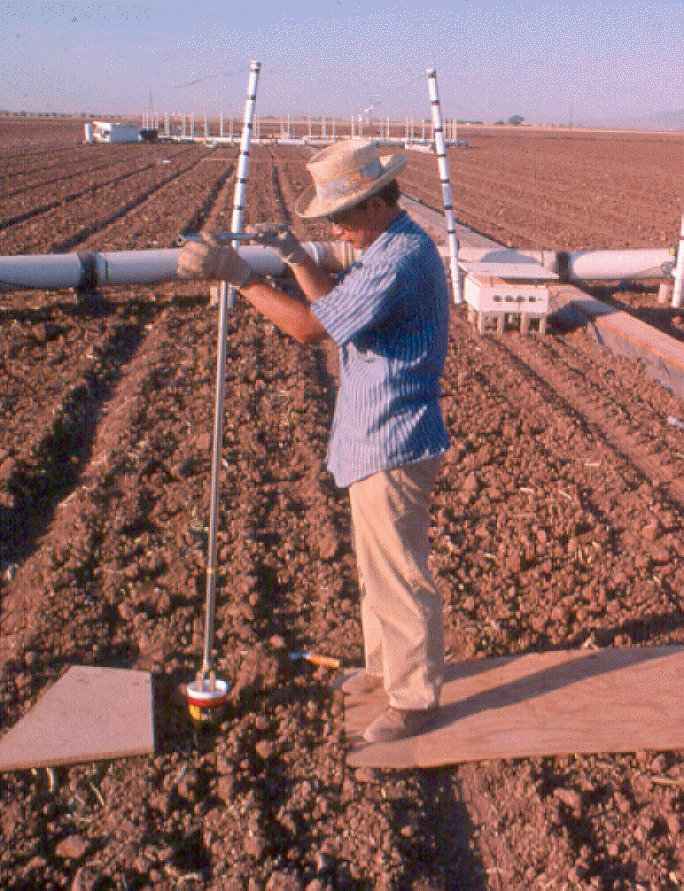 Li
Cheng
Li
Cheng
Ph.D. Completed May 2005
Contact Information:
Dr. Li Cheng
NSF AMS Accelerator Facility
Dept. of Physics
PAS Bldg.
University of Arizona
Tucson, AZ 85721
NSF AMS Accelerator Facility
Lab. of Tree-Ring Research
105 W. Stadium, Bldg. #58
University of Arizona
Tucson, AZ 85721
E-mail: lcheng@ltrr.arizona.edu
Ph.D project: Elevated Atmospheric CO2 Impacts Carbon Dynamics in a C4-Sorghum-Soil Agroecosystem- An Application of Stable Carbon Isotopes (õ13C) in Tracing the Fate of Carbon in the Atmosphere-Plant-Soil Ecosystem
Arizona Maricopa Free-Air Carbon Dioxide Enrichment
(FACE) Experiment
Seasonal Soil Respiration and Soil CO2 under Elevated CO2
in the Sorghum Agroecosystem
Department of Soil, Water and Environmental Sciences
The Unversity of Arizona
Li Cheng
(Poster presented at Ecological Society of America Annual Meeting, Tucson, Arizona, 4-9 August, 2002 )
Abstract
Soil respiration directly transfers soil organic carbon (SOC) to atmosphere
and may determine success of soil carbon sequestration schemes. However,
the effects of elevated CO2 on soil respiration are still poorly
understood, especially in the open-field ecosystems. Our study investigated
the variations of soil respiration under elevated CO2 during
1998 and 1999 sorghum growing seasons at the Free-Air CO2 Enrichment
(FACE) experiment at the University of Arizona Maricopa Experimental Farm.
Soil respiration was measured at the soil surface with a Licor-6200 and
soil air was sampled at depths of 15 cm and 30cm at biweekly intervals.
Two-year average soil CO2 efflux from elevated CO2
(ambient + 200 mol mol-1) plots was 3.3 mol m-2s-1,
about 13% greater than that from control (ambient CO2 concentration
360 mol mol-1) plots, but the seasonal pattern in 1998 was different from
1999. Soil CO2 efflux under elevated CO2 in 1998
increased from 3% to 107% significantly throughout the growing season,
whereas in 1999 large increases in soil CO2 efflux occurred
during later stages of growth, and before sorghum heading the CO2-enriched
plot had lower soil CO2 efflux than the control. To further
understand the belowground C cycling, isotopic carbon ( d13C)
analysis of soil air collected from the soil profile was used to resolve
root respiration and old SOC decomposition in the soil CO2
efflux. Our results indicate that although elevated CO2 increased
soil CO2 efflux significantly, about 55% of the increased CO2
flux was derived from root respiration and only 45% came from old SOC
decomposition. Compared with control over two growing seasons, elevated
CO2 increased root respiration by an average of 18%, but the
effect on old SOC decomposition was not constant---stimulating SOC decomposition
by 28% in 1998 and reducing it by 3% in 1999.
Free Air-CO2 Enrichment (FACE) of C4-Sorghum: Biochemical Composition and Decomposition of Sorghum Tissues Grown Under Elevated CO2
The Unversity of Arizona
Li Cheng
(Poster presented at ASA-CSSA-SSSA Annual Meeting, Denver, Colorado, 2-6
November, 2003
Abstract
Biochemical composition of sorghum tissue grown under elevated CO2
was determined in Free-Air CO2 Enrichment (FACE) experiment
during the 1998-1999 growing seasons at Maricopa, Arizona, USA. Sorghum
samples were collected from FACE (560 ppmv CO2 ) wet (well-watered)
and dry (water-limited), and Control (360 ppmv CO2) wet and
dry plots at the end of 1999 growth season. Elevated CO2 increased
cellulose and lignin by 40% and 5%, respectively, while total non-structural
carbohydrates and amino acids were reduced by 8% and 7%, respectively.
Phenolics were significantly higher in FACE roots, but not significant
different in FACE leaves and stems. Water stress modified the CO2
effects, especially for uronic acids that were increased in FACE-wet by
7% and reduced in FACE-dry sorghum tissues by 3%. The C/N ratio in sorghum
tissues was not affected by CO2, but was substantially lower
under water stress. Laboratory incubation of soil amended with sorghum
tissues showed the decomposition rate of FACE sorghum tissues was on average
14% lower than control sorghum tissues after 30 day incubation; consequently,
23% more new organic carbon was left in the incubated soil amended with
FACE sorghum tissues based on isotope mass balance. The results confirm
the slower decomposition of FACE plant tissue reported in literature apparently
due to biochemical changes in the plant tissue.